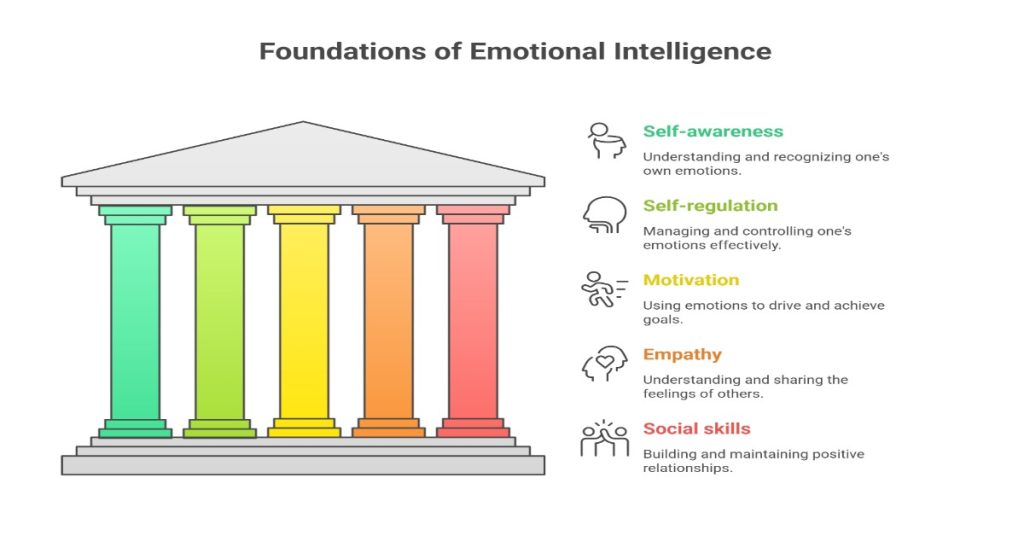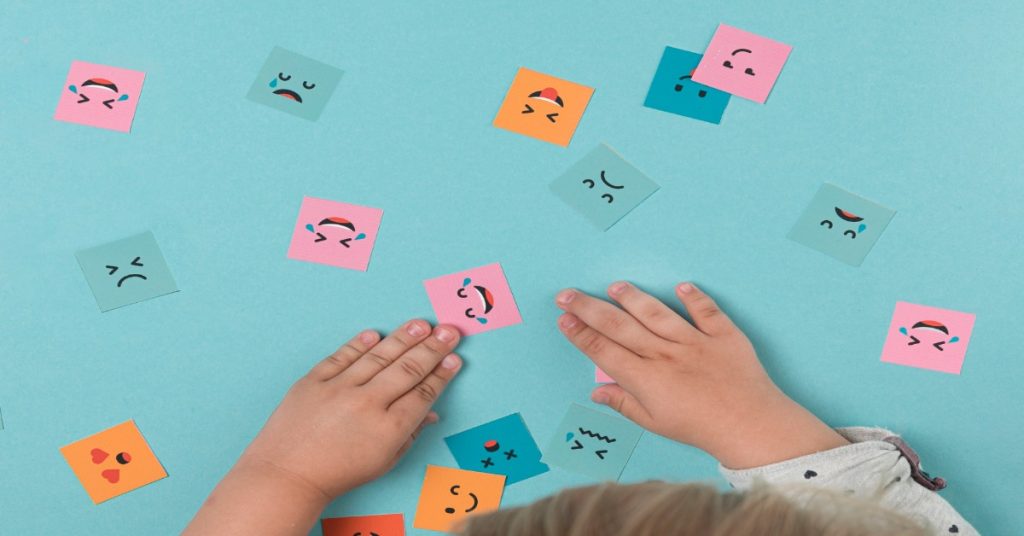
Have you ever watched your child melt down over a spilled juice box, or seen them struggle to make friends at the playground? Those moments can feel overwhelming, like you’re constantly putting out fires.
As a parent, you want your kid to thrive not just in math tests, but in handling their big feelings and getting along with others. That’s where emotional intelligence comes in. It’s the skill set that helps kids understand their emotions, manage them, and connect with people around them.
In this post, we’ll break down why building emotional intelligence in children is a game-changer for their future. We’ll look at the real reasons it counts, spot the signs that your child could use a little more of it, and share straightforward ways to teach it right at home. By the end, you’ll have actionable steps to help your kid build these skills, turning those tough moments into opportunities for growth. Let’s get into it.
What Exactly Is Emotional Intelligence?
Think back to your own childhood. Did you always know why you felt angry or sad? Emotional intelligence, or EI, is basically the ability to recognize and handle emotions yours and others’. It’s not about being “smart” in the bookish sense; it’s about being wise with feelings.
At its core, EI has five key parts:
- Self-awareness: Knowing what you’re feeling and why. A child who says, “I’m mad because my toy broke,” is already practicing this.
- Self-regulation: Keeping those feelings in check so they don’t take over. It’s the difference between yelling in frustration and taking a deep breath first.
- Motivation: Using emotions to push toward goals, like bouncing back from a bad day at school with a positive attitude.
- Empathy: Understanding how someone else feels. This is what stops a kid from teasing a classmate who’s upset.
- Social skills: Building relationships through clear communication and teamwork.
These aren’t fancy concepts, they’re everyday tools. Research from psychologists like Daniel Goleman shows that kids with strong EI do better in school, have fewer behavior issues, and even enjoy stronger family bonds. But here’s the thing: EI isn’t something kids are born with fully formed. It grows with practice, just like riding a bike.
If you’ve noticed your child bottling up emotions or lashing out unexpectedly, don’t worry. You’re not alone, and it’s fixable. Teaching EI starts with small, consistent steps that fit into your busy routine.

The Real Reasons Emotional Intelligence Counts for Kids
Raising kids in today’s world is no small task. Between screen time, school pressures, and social media glimpses of “perfect” lives, children face a whirlwind of emotions. Without EI, those feelings can build up like steam in a pressure cooker, leading to outbursts, anxiety, or even withdrawal.
One big pain point? Tantrums and meltdowns that seem to come out of nowhere. You might think, “Why can’t they just calm down?” The truth is, young brains are still wiring themselves to process emotions. A study from Yale’s Center for Emotional Intelligence found that kids who learn EI early have 20% fewer behavioral problems. They handle disappointment better, like when they don’t win the game, without throwing the controller.
Another common struggle is making friends. Remember the sting of seeing your child left out at recess? Low EI can make it hard for kids to read social cues like knowing when a friend needs space or how to apologize after a fight. This isolation hurts their confidence and can follow them into adulthood, where poor relationships lead to stress at work or home.
And let’s talk academics. Sure, straight A’s are great, but EI helps kids stay focused and resilient. When a test goes wrong, an emotionally intelligent child learns from it instead of giving up. Harvard research backs this: EI predicts 80% of adult success, far more than IQ alone.
The good news? Prioritizing EI now pays off big. Your child will navigate friendships with ease, bounce back from failures, and even sleep better at night. It’s not about perfection, it’s about giving them the inner strength to face life’s ups and downs. If you’re feeling stuck on where to start, the next sections have your back with simple strategies.
Spotting the Signs: Does Your Child Need More Emotional Intelligence?
Every parent has those “aha” moments when you realize something’s off. Maybe your five-year-old cries every time plans change, or your ten-year-old argues with siblings over nothing. These aren’t just “phases” ; they could signal a need for EI support.

Here are a few telltale signs:
- Frequent outbursts: If small triggers lead to big reactions, like slamming doors over homework, it points to weak self-regulation.
- Difficulty sharing feelings: Kids who say “I’m fine” when they’re clearly not might lack self-awareness. This bottling up can turn into anxiety later.
- Struggles with empathy: Teasing others without realizing it hurts, or not comforting a sad playmate, shows room for growth in understanding emotions.
- Low resilience: Quitting activities after one setback, like dropping soccer after missing a goal, means motivation tied to feelings needs work.
- Social hiccups: Being overly shy in groups or dominating conversations without listening hints at underdeveloped social skills.
Sound familiar? You’re not failing as a parent; these are normal hurdles. The key is catching them early. Talk to your child’s teacher for school insights, or keep a quick journal of emotional patterns at home. Once you see the signs, you can jump into teaching tools that make a real difference.
Practical Ways to Teach Emotional Intelligence at Home
Ready to roll up your sleeves? Teaching EI doesn’t require fancy programs or endless therapy sessions. It’s about weaving it into daily life with fun, low-pressure activities. Start small, and watch your child light up as they gain confidence.
Build Self-Awareness with Feeling Check-Ins
Begin each day or mealtime with a quick “feelings chat.” Ask, “On a scale of 1 to 5, how happy are you right now, and why?” Use simple emotion cards, print free ones online with faces showing happy, sad, angry, etc. This helps kids name their emotions, turning vague frustration into “I’m disappointed because.”
Pain point solved: No more guessing games about what’s wrong. Over time, your child will spot patterns, like getting grumpy when tired, and adjust on their own.
Practice Self-Regulation Through Calm-Down Routines
When tempers flare, teach breathing tricks like “balloon breaths” inhale to fill your belly like a balloon, exhale slowly. Make it a game: Time each other to see who can hold the calm longest. For older kids, try a “pause button” rule: Count to 10 before reacting to a sibling poke.
This tackles the meltdown cycle head-on. Kids learn to hit pause, reducing those embarrassing public scenes and building inner control.

Spark Motivation with Goal-Setting Talks
Help your child link emotions to actions. After a tough day, say, “What felt good about trying anyway?” Celebrate small wins, like finishing a puzzle despite frustration, with high-fives or stickers. Avoid over-praising outcomes and focus on effort to build that inner drive.
Struggling with an unmotivated kid? This shifts the focus from “I failed” to “I grew,” making homework battles rarer.
Grow Empathy with Storytime and Role-Play
Read books like *The Color Monster* together, pausing to ask, “How do you think the monster feels here? What would you do?” For real life, role-play scenarios: “Pretend your friend lost their lunch, what do you say?”
This directly addresses friendship woes. Empathetic kids become the ones others turn to, boosting their social circle and self-esteem.
Strengthen Social Skills with Family Games
Turn dinner into a sharing circle: Each person says one kind thing they noticed about another. Or play board games that require turns and teamwork, like cooperative ones where everyone wins together.
If group play feels awkward for your child, these low-stakes practices build confidence without the playground pressure.
Aim for 10-15 minutes a day. Consistency beats intensity. Your involvement shows them emotions are safe to discuss. Track progress in a family chart; seeing stickers add up keeps everyone motivated.
Bringing It All Together: Parents, Schools, and Community
You’re the frontline coach, but you’re not in it alone. Schools play a huge role too. Many now include EI in curriculums, like mindfulness breaks or peer mediation clubs. Chat with your child’s teacher about what they’re doing, maybe join a parent workshop.
Communities matter as well. Look for local playgroups or apps like GoZen that offer kid-friendly EI videos. When parents team up, kids see emotions modeled everywhere, from home to the soccer field.
One parent’s story: Sarah noticed her eight-year-old withdrawing after a move. She started weekly “emotion walks” just chatting feelings while strolling. Paired with school counseling, her son opened up, made friends, and his grades climbed. Small changes, big ripples.

The Lasting Impact of Emotional Intelligence on Your Child’s Life
Investing in EI today shapes tomorrow. Kids who master these skills enter adulthood ready for real-world challenges like job stress or relationship bumps without crumbling. Studies from the University of Illinois show EI-trained children have lower depression rates and higher life satisfaction by their 20s.
Imagine your teen handling college rejection with grace, or your adult child leading a team with compassion. That’s the payoff. And for you? Fewer daily battles mean more joyful family time.
It’s never too late to start, whether your kid is three or thirteen. The foundation you lay now becomes their superpower.
Read More
The Best Kids’ Programs for Teaching Problem-Solving Skills
Why Public Speaking is a Must-Have Skill for Your Child?
How to Encourage Kids to Dream Big and Set Goals?
Wrapping It Up: Start Small, See Big Changes
Emotional intelligence isn’t a buzzword, it’s the quiet force behind happy, capable kids. From understanding their own moods to lifting others up, EI equips them for a fuller life. You’ve got the signs to watch for and the home-based tips to try, all without overhauling your schedule.
Pick one strategy this week like a feelings check-in and build from there. Your child will thank you later, even if it’s with an eye-roll now. What’s one EI win you’ve seen in your family? Share in the comments I would love to hear and cheer you on.
